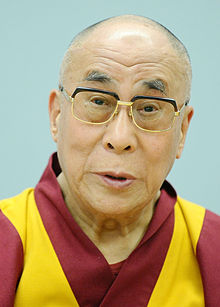| Dalai Lama | |
|---|---|
| ཏཱ་ལའི་བླ་མ་ | |
| Residence |
|
| Formation | 1391 |
| First holder | Gendün Drubpa, 1st Dalai Lama, posthumously awarded after 1578. |
| Website | dalailama |
Dalai Lama (UK: /ˈdælaɪ ˈlɑːmə/, US: /ˈdɑːlaɪ/;[1][2] Tibetan: ཏཱ་ལའི་བླ་མ་, Wylie: Tā la'i bla ma [táːlɛː láma]) is a title given by Altan Khan, the first Shunyi King of Ming China. He offered it in appreciation to the leader of the Gelug school of Tibetan Buddhism, Sonam Gyatso, who received it in 1578 at Yanghua Monastery.[3] At that time, Sonam Gyatso had just given teachings to the Khan, and so the title of Dalai Lama was also given to the entire tulku lineage. Sonam Gyatso became the 3rd Dalai Lama, while the first two tulkus in the lineage, the 1st Dalai Lama and the 2nd Dalai Lama, were posthumously awarded the title.
All tulkus in the lineage of the Dalai Lamas are considered manifestations of the Buddha Avalokiteshvara,[2][1] the bodhisattva of compassion.[4][5]
Since the time of the 5th Dalai Lama in the 17th century, the Dalai Lama has been a symbol of unification of the state of Tibet.[6] The Dalai Lama was an important figure of the Gelug tradition, which was dominant in Central Tibet, but his religious authority went beyond sectarian boundaries, representing Buddhist values and traditions not tied to a specific school.[7] The Dalai Lama's traditional function as an ecumenical figure has been taken up by the fourteenth Dalai Lama, who has worked to overcome sectarian and other divisions in the exile community and become a symbol of Tibetan nationhood for Tibetans in Tibet and in exile.[8] He is Tenzin Gyatso, who escaped from Lhasa in 1959 during the Tibetan diaspora and lives in exile in Dharamsala, India.
From 1642 and the 5th Dalai Lama until 1951 and the 14th Dalai Lama, the lineage was enjoined with the secular role of governing Tibet. During this period, the Dalai Lamas or their Kalons (or regents) led the Tibetan government in Lhasa, known as the Ganden Phodrang. It governed all of the Tibetan Plateau while respecting varying degrees of autonomy.[9] In 1959, the 14th Dalai Lama revoked Tibet's Seventeen Point Agreement with China, at which point he legally returned to the secular leadership position of governing Tibet.
As both spiritual and secular leaders, the Dalai Lama tulku lineage also undertook priest and patron relationships with neighbors, including Mongolian leaders, kings of the Khoshut, and leaders of the Dzungar Khanates (1642–1720). These relationships occurred simultaneously with the priest and patron relationship between Tibet and the emperors of the Manchu-led Qing dynasty (1720–1912),[9] which officially continued until the Collapse of the Qing empire in 1912.
- ^ a b "Definition of Dalai Lama in English". Oxford Dictionaries. Archived from the original on 27 July 2013. Retrieved 2 May 2015.
The spiritual head of Tibetan Buddhism and, until the establishment of Chinese communist rule, the spiritual and temporal ruler of Tibet. Each Dalai Lama is believed to be the reincarnation of the bodhisattva Avalokitesvara, reappeared in a child when the incumbent Dalai Lama dies
- ^ a b "Dalai lama". Dictionary.com. Archived from the original on 26 February 2014. Retrieved 12 March 2014.
(formerly) the ruler and chief monk of Tibet, believed to be a reincarnation of Avalokitesvara and sought for among newborn children after the death of the preceding Dalai Lama
- ^ 陈庆英 (2003). 达赖喇嘛转世及历史定制. 五洲传播出版社. ISBN 978-7-5085-0272-4. 达赖喇嘛的名号产生于公元1578年。当时格鲁派大活佛索南嘉措应土默特蒙古首领顺义王俺达汗邀请到蒙古地方弘扬佛法。在青海仰华寺,索南嘉措对藏传佛教的理论进行了广泛的阐述,使这位蒙古首领对他产生了仰慕之心,于是赠给尊号“圣识一切瓦齐尔达喇达赖喇嘛”的称号. The name Dalai Lama was created in 1578 AD, in that year, Sonam Gyatso was invited by Anda (Altan Khan), the leader of the Tümed Mongols, to Mongol area (蒙古地方) to promote Buddhism. At Yanghua Monastery in [sic] Qinghai, Sonam Gyatso gave an extensive exposition of the theories of Tibetan Buddhism, which made the Mongol leader admire him and gave him the title "Holy Knowing Everying Vajradhara Dalai Lama" title.
- ^ Peter Popham (29 January 2015). "Relentless: The Dalai Lama's Heart of Steel". Newsweek. Archived from the original on 29 April 2015. Retrieved 1 May 2015.
His mystical legitimacy – of huge importance to the faithful – stems from the belief that the Dalai Lamas are manifestations of Avalokiteshvara, the Bodhisattva of Compassion
- ^ Laird 2006, p. 12.
- ^ Woodhead, Linda (2016). Religions in the Modern World. Abingdon: Routledge. p. 94. ISBN 978-0-415-85881-6.
- ^ Religions in the Modern World: Traditions and Transformations. Taylor and Francis. Kindle locations 2519–2522.
- ^ Cantwell and Kawanami (2016). Religions in the Modern World. Routledge. p. 94. ISBN 978-0-415-85880-9.
- ^ a b Smith 1997, pp. 107–149.
